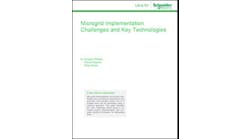Chicago-based Commonwealth Edison is once again vying for legislative approval to invest in microgrids, including what it hopes will be the world’s first microgrid cluster.
The Exelon subsidiary seeks an okay to invest $250 million for five microgrids, as part of a comprehensive Future Energy Jobs Bill (Senate Bill 2814), introduced Wednesday into the Illinois General Assembly.
The utility had sought approval of the microgrids in earlier energy legislation that failed to go forward because of issues unrelated to the microgrids.
In a news conference Wednesday morning, Fidel Marquez, ComEd’s senior vice president, government and external affairs, said the new legislation would create the “world’s first microgrid cluster” and “one of the most resilient systems in the country.”
The plan calls for the microgrids to serve critical facilities in the Bronzeville community on Chicago’s South Side, the Illinois Medical District in Chicago, DuPage County government complex, Chicago Heights water pumping & treatment facility and the Rockford International Airport.
Microgrid cluster in Bronzeville
The 10-MW Bronzeville project would connect with the 12-MW Illinois Institute of Technology (IIT) microgrid to create a microgrid cluster or grid of microgrids.
The idea of the microgrid cluster – microgrids sharing resources through advanced controllers – continues to gain traction. Some futurists envision microgrid clusters eventually becoming the primary source of U.S. electricity with the main grid acting as a backup. The concept is still conceptual, but microgrid cluster projects are on the drawing board in Pittsburgh, California and elsewhere. ComEd is working on a super microgrid control that would allow communication between microgrids within a cluster.
The Illinois legislation would allow the utility to recover costs for the five test microgrids through an automatic adjustment clause tariff or through a delivery services charge. The microgrid plans would be subject to approval by the state public utilities commission.
In addition to providing power for critical facilities during an outage, the microgrids could sell services into the wholesale market during normal operations, according to the bill.
Addresses competitive concerns
The legislation addresses concerns raised in other restructured states that utility microgrids may infringe on retail choice. At issue is whether they create captive customers – without retail choice – when they island and supply electricity during a power outage. But the ComEd projects are not about selling generation to retail customers; they instead sell reliability, according to the utility.
The microgrids act as a “distribution system reliability function and not as a retail sale of power,” according to language in the bill. Or as Marquez put it, the microgrids are not meant as a generation play, but are a “grid reliability, resiliency play.”
The bill also addresses concerns that utilities will attempt to shut out competitors and become the sole developers of microgrids. If passed, it will not “limit or expand the ability of any other entity to develop, construct, or install a microgrid.” ComEd has said that it sees a role for utilities in building community or public purpose microgrids, while leaving private microgrids to the competitive market.
ComEd would build the microgrids over a five-year period and continue to own and operate them. Among other things, they would serve as test beds for studying the high penetration of renewable energy on the grid.
The legislation anticipates the microgrid projects creating 300 jobs.
[clickToTweet tweet=”Exelon Pushes World’s First #Microgrid Cluster in New Illinois Bill” quote=”Exelon Pushes World’s First Microgrid Cluster in New Illinois Bill”]
Other provisions in the bill
The Future Energy Jobs Bill has won support from a coalition of interest groups, among them environmentalists, consumer advocates and community leaders that joined ComEd in Wednesday’s news conference. Over the last 18 months, the groups have worked together to combine multiple earlier energy bill, some that included the microgrids, into one comprehensive package.
In addition to okaying cost recovery for the microgrids, the bill would double energy efficiency programs to create $4 billion in energy savings. Is also would accelerate renewable energy development and create a Zero Emission Standard (ZES) meant to preserve the state’s at-risk nuclear plants.
“We’ve listened to and worked with key environmentalists, consumer advocates, and community and faith leaders in developing this legislation, with the shared goal of delivering policy solutions that create innovative pathways to a sustainable future,” said Marquez. “We look forward to continuing to work with stakeholders to refine and pass legislation that delivers so many benefits for our consumers, economy and environment.”
Will the microgrid cluster become a big part of the US grid in the future? Let us know your thoughts on our LinkedIn group, Microgrid Knowledge or in the comments section below.






